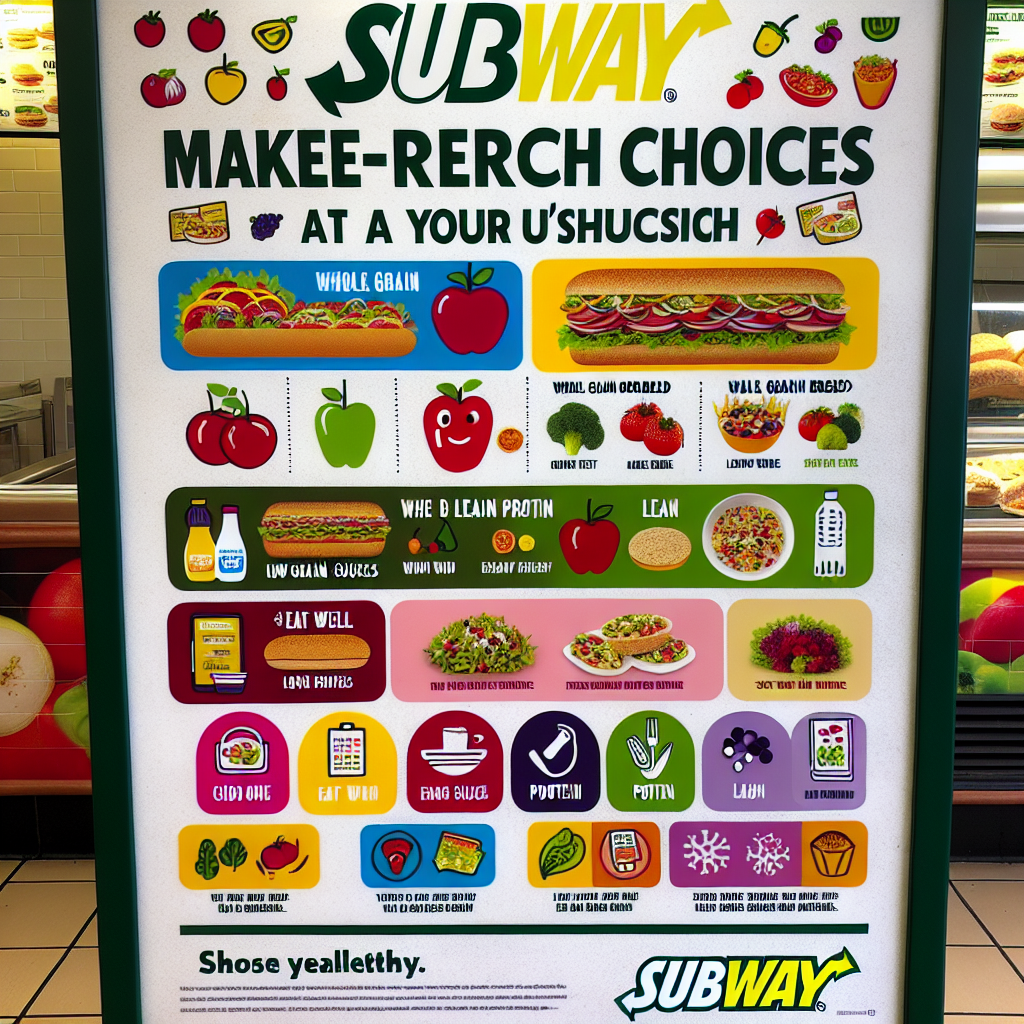Fueling Your Subway Cravings: A Guide to Nutritious Choices

Subway has become a popular choice for many people when it comes to grabbing a quick and satisfying meal. With their wide variety of sandwiches and customizable options, it’s no wonder that people crave their delicious creations. However, it’s important to make healthy choices when ordering at Subway to ensure that you are fueling your body with nutritious ingredients.
Key Takeaways
- Understanding your Subway cravings can help you make healthier choices.
- Subway sandwiches can be a nutritious option with a variety of fresh vegetables and lean meats.
- Choosing the right bread can make a big difference in the nutritional value of your Subway sandwich.
- Adding fresh vegetables to your Subway order can increase the nutritional value and add flavor.
- Including meat in your Subway sandwich can have both pros and cons for your health.
The Nutritional Value of Subway Sandwiches
One of the reasons why Subway sandwiches are so popular is because they offer a healthier alternative to traditional fast food options. Subway sandwiches are typically lower in calories and fat compared to other fast food options, making them a great choice for those who are watching their waistline. Additionally, Subway offers a variety of fresh vegetables and lean proteins that can help you meet your daily nutritional needs.
When ordering at Subway, it’s important to choose the right ingredients to maximize the nutritional value of your sandwich. Opt for whole grain breads instead of white breads, as they are higher in fiber and provide more nutrients. Choose lean proteins such as turkey or chicken breast, and load up on fresh vegetables to add vitamins and minerals to your meal.
Tips for Choosing the Right Bread for Your Subway Sandwich
Subway offers a variety of bread options to choose from, including Italian, wheat, and flatbread. When choosing the healthiest option, it’s important to consider the nutritional value of each type of bread.
Whole grain breads are a great choice because they are higher in fiber and provide more nutrients compared to white breads. They can help keep you feeling fuller for longer and provide sustained energy throughout the day. If you prefer a lighter option, consider choosing the flatbread, which is lower in calories and fat compared to other bread options.
The Benefits of Adding Fresh Vegetables to Your Subway Order
| Benefit | Description |
|---|---|
| Increased Nutrient Intake | Fresh vegetables are packed with essential vitamins and minerals that are important for overall health and wellbeing. |
| Improved Digestion | The fiber found in fresh vegetables can help regulate digestion and prevent constipation. |
| Lowered Risk of Chronic Diseases | Eating a diet rich in fresh vegetables has been linked to a lower risk of chronic diseases such as heart disease, diabetes, and certain types of cancer. |
| Weight Management | Fresh vegetables are low in calories and high in fiber, making them a great addition to any weight management plan. |
| Improved Mood | The nutrients found in fresh vegetables have been shown to improve mood and reduce symptoms of depression and anxiety. |
Adding fresh vegetables to your Subway sandwich is a great way to boost its nutritional value. Vegetables are packed with vitamins, minerals, and fiber, which are essential for maintaining a healthy diet.
Subway offers a variety of vegetable options, including lettuce, tomatoes, cucumbers, onions, and peppers. These vegetables not only add flavor and crunch to your sandwich, but they also provide important nutrients. Lettuce and spinach are rich in vitamins A and K, while tomatoes are a great source of vitamin C. Cucumbers are hydrating and provide a refreshing crunch, while onions and peppers add a burst of flavor.
The Pros and Cons of Including Meat in Your Subway Sandwich
Meat can be a great source of protein and other essential nutrients. However, it’s important to consider the nutritional benefits and drawbacks of including meat in your Subway sandwich.
Lean meats such as turkey or chicken breast are lower in fat and calories compared to processed meats like salami or pepperoni. These lean proteins can help you meet your daily protein needs without adding excess calories or fat to your meal. However, it’s important to be mindful of portion sizes when adding meat to your sandwich, as too much can increase the calorie content.
Understanding the Role of Cheese in Your Subway Sandwich

Cheese is a delicious addition to any sandwich, but it’s important to choose the right type of cheese to maximize its nutritional value.
Cheese is a good source of calcium and protein, but it can also be high in saturated fat and sodium. When choosing cheese for your Subway sandwich, opt for lower-fat options such as Swiss or mozzarella. These cheeses still provide flavor and texture without adding excessive calories or fat.
How to Make Your Subway Sandwiches Healthier by Choosing the Right Sauces
Sauces can add flavor and moisture to your Subway sandwich, but they can also be high in calories and unhealthy fats. It’s important to choose the right sauce options to keep your meal nutritious.
Opt for lighter sauce options such as mustard, vinegar, or hot sauce, which are lower in calories and fat compared to creamy dressings or mayonnaise. These lighter options can still add flavor to your sandwich without adding excessive calories or unhealthy fats.
The Importance of Portion Control When Eating at Subway
Portion control is key when it comes to maintaining a healthy diet, even when eating at Subway. It’s important to be mindful of the portion sizes of your sandwich and other menu items.
Subway offers a variety of sandwich sizes, including 6-inch and footlong options. Opt for the smaller size if you are looking to control your calorie intake. Additionally, be mindful of the amount of meat, cheese, and sauces you add to your sandwich, as these can quickly increase the calorie content.
Making Smart Choices When Ordering Sides and Drinks at Subway
In addition to sandwiches, Subway also offers a variety of sides and drinks. It’s important to make smart choices when ordering these items to ensure that you are making nutritious choices.
When it comes to sides, opt for healthier options such as a side salad or apple slices instead of chips or cookies. These options provide important nutrients without adding excessive calories or unhealthy fats.
When it comes to drinks, choose water or unsweetened beverages instead of sugary sodas or juices. These options are lower in calories and sugar, and can help you stay hydrated throughout the day.
Fueling Your Subway Cravings with Nutritious Choices
While Subway can be a delicious and convenient option for a quick meal, it’s important to make healthy choices when ordering. By choosing the right ingredients, controlling portion sizes, and making smart choices with sides and drinks, you can fuel your Subway cravings with nutritious choices. Remember to load up on fresh vegetables, choose lean proteins, and opt for whole grain breads to maximize the nutritional value of your meal.
If you’re interested in learning more about subway nutrition and making healthier food choices, you might find this article on “The Ultimate Guide to a Healthy Diet” helpful. It provides valuable information on the importance of balanced nutrition and offers tips for beginners on how to make smart food choices. Check it out here.
FAQs
What is Subway Nutrition?
Subway Nutrition refers to the nutritional value of the food items served at Subway restaurants. It includes information about the calorie, fat, protein, carbohydrate, and sodium content of the food.
What are the healthy options at Subway?
Subway offers a variety of healthy options such as salads, sandwiches made with whole-grain bread, and fresh vegetables. Customers can also choose lean protein options like turkey, chicken, and roast beef.
What are the calorie counts of Subway sandwiches?
The calorie counts of Subway sandwiches vary depending on the type of bread, meat, cheese, and toppings used. However, most six-inch sandwiches contain between 300 and 500 calories, while footlong sandwiches contain between 600 and 900 calories.
What are the sodium levels in Subway sandwiches?
The sodium levels in Subway sandwiches vary depending on the type of sandwich and toppings used. However, most sandwiches contain between 500 and 1,500 milligrams of sodium.
Are Subway sandwiches gluten-free?
Subway offers gluten-free bread at select locations, but customers should be aware that cross-contamination may occur during the preparation process.
What are the vegetarian options at Subway?
Subway offers a variety of vegetarian options such as the Veggie Delite sandwich, salads, and sides like chips and apple slices. Customers can also customize their sandwiches with a variety of vegetables and sauces.